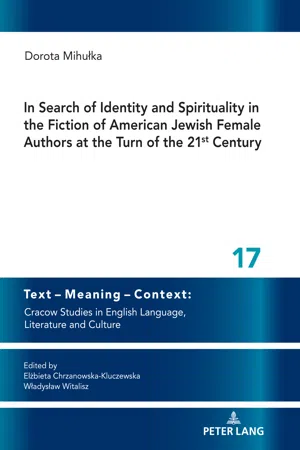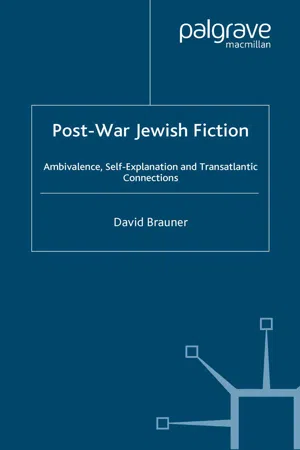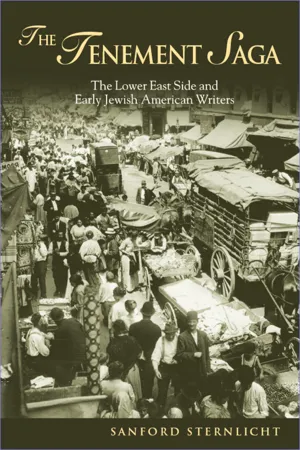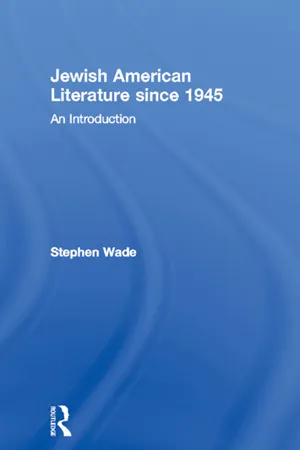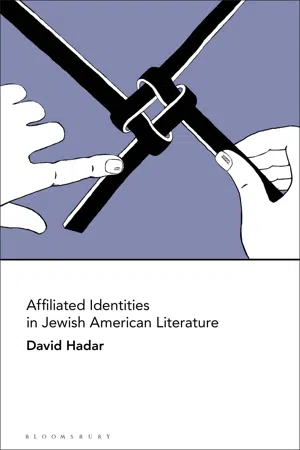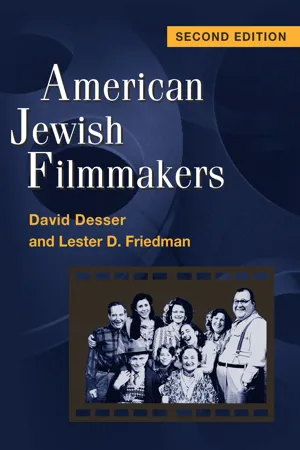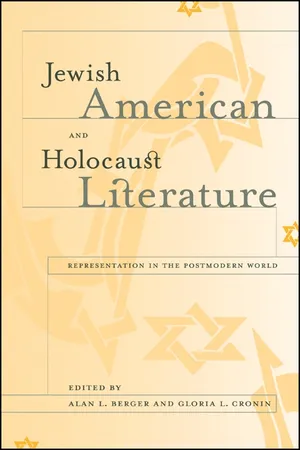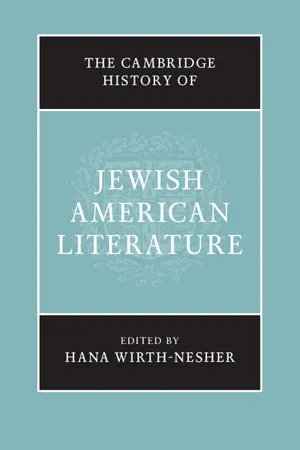Literature
American Jewish Fiction
American Jewish fiction refers to literature written by American authors of Jewish descent, often exploring themes of identity, tradition, and the immigrant experience. These works frequently delve into the complexities of Jewish culture and history in the United States, offering insights into the challenges and triumphs of the Jewish-American experience. Notable authors in this genre include Philip Roth, Saul Bellow, and Cynthia Ozick.
Written by Perlego with AI-assistance
Related key terms
1 of 5
11 Key excerpts on "American Jewish Fiction"
- David Seed(Author)
- 2010(Publication Date)
- Wiley-Blackwell(Publisher)
The fiction of some of these younger writers has been characterized by a stronger interest in Judaism, the Holocaust, Old World history (real and imagined), and Israel than was evident in their predecessors. For others, however, their Jewishness seems as incidental as it was for Norman Mailer. Many of them are clearly influenced by postmodernist, experimental modes of writing; others are closer in spirit to the realism that has proved more tenacious in twentieth-century American fiction than the enthusiasts of modern- ism or postmodernism would have us believe. In other words, it is very difficult to generalize about the state of contemporary Jewish American fiction, and this hetero- geneity is both its strength and its weakness. In an arena increasingly dominated by identity politics, the more fashionable, and more readily identifiable, ethnic literatures (African American, Asian American, Latino/a American, Native American) have tended to displace Jewish American literature on college courses and in academic discourses. On the other hand, Jewish American authors, whether elder statesmen/ women such as Roth and Ozick, or young pretenders such as Chabon and Foer, are now free, in a way that was arguably never quite the case during the twentieth century, to publish fiction that is judged on its own merits rather than as the product of a putative school of Jewish American fiction. References and Further Reading Antler, Joyce, ed. (1990). America and I: Short Stories by American Jewish Women Writers. Boston: Beacon. Bellow, Saul (1965). Herzog. Harmondsworth: Penguin. Brauner, David (2001). Post-War Jewish Fiction: Ambivalence, Self-Explanation and Transatlantic Connections. London: Palgrave/Macmillan. Chametzky, Jules, Felstiner, John, Flanzbaum, Hilene, et al., eds. (2001). Jewish American 108 David Brauner Literature: A Norton Anthology. New York: Norton. Fiedler, Leslie (1991). Fiedler on the Roof: Essays on Literature and Jewish Identity.- eBook - ePub
Women and Judaism
New Insights and Scholarship
- Frederick E. Greenspahn(Author)
- 2009(Publication Date)
- NYU Press(Publisher)
For a greater part of the 20th century, Jewish American literature was the literature of immigrants and their children, writing their way into American culture. Their fiction captured the process of acculturation, most often marked by distancing from Jewish traditional practices. They dealt with such issues as ethics, immigration, exclusion, acculturation, assimilation, and historical trauma. When it appeared in these works at all, Judaism was presented either critically or nostalgically, viewed as a relic of a European life left behind. It built upon a body of historical or textual memories that were presented, in American literature, as oppressive or inspiring as American Jews moved into a secularized, Americanized modern future. In a sense, literature presented itself as an alternative grounding for Jewish ethics and values, taking the place of religious learning and practice and the mores of a tightly bound community. In fact, virtually all scholars understood Jewish literature in North America to be a secular discourse, however much its texts might gesture to religious texts, ritual practices, and remembered communities.In different ways, these three works introduced a new element into Jewish American literature: the articulation of a Jewish feminist narrative in a context that sees Judaism as a source of meaningfulness, however contentious, for Jewish women. Incorporating Jewish texts, history, legends, and culture, these novels mark a reversal of a movement away from Judaism that had marked Jewish American literature up to that time. The issues at the heart of fiction by authors such as Rapoport, Roiphe, and Broner figure importantly in contemporary fiction by North American Jewish women writers.New Wave of Jewish American Women’s Writing
As part of what has been termed a “new wave” of Jewish American writing published at the turn of the century, contemporary Jewish American writers write out of a context already deeply affected by Jewish feminism. Mainstream synagogues and other Jewish communal organizations have taken on different configurations in response to feminist critiques, and, as individuals, American Jews think about such things as ethnic and religious identity differently than they had in the past. Jewish writing by both men and women reflects, probes, and challenges this changed Jewish American landscape.22 - eBook - PDF
Books and Beyond
The Greenwood Encyclopedia of New American Reading [4 volumes]
- Kenneth Womack(Author)
- 2008(Publication Date)
- Greenwood(Publisher)
History. The notion that Israel and an image of Jewish life that perceives the state as the primary homeland need not remain a defining facet of Jewish identity for those Jews who live outside of the state is perhaps nowhere more evident than in the diversity of Jewish American literary expressions of the past decade. Jewish American writing began as the first manifestation of immigrant writing in the United States, and later transitioned into what we might call the literature of assimilated Jews in the middle and later part of the twentieth century. The writing of the last decade is unique in that a single unifying characteristic is lacking from the body of work as a whole. The most recent writing of American Jews depicts a diverse community of people who are at home in America. These are people whose concerns about Judaism or Jewishness—although it should be noted that a number of the more recent American Jewish writers, Paul Auster for instance, seem not to be overly con- cerned with this at all—have more to do with what it means to be an American who also happens to be a Jew. Sometimes—as in the case of writers like Shalom Auslander (Beware of God, 2005), Pearl Abraham (The Romance Reader, 1996), Tova Mirvis (The Ladies Auxiliary, 2000), and even Allegra Goodman (Kaaterskill Falls, 1998)—this means responding directly to Jewish rituals and traditions, whether through critiquing, rejecting, or redefining them. It is interesting to note, however, that the books that follow in many of these writers’ repertoires often move completely away from such concerns. Judaism and Jewish community, for example, which dominate the con- cerns of the religious enclave in Goodman’s Kaaterskill Falls, could not be farther from the minds of the characters in Goodman’s Intuition (Goodman 2006), who are comprised primarily of postdoctoral researchers in a scientific laboratory. - Dorota Mihulka(Author)
- 2020(Publication Date)
- Peter Lang Group(Publisher)
Apart from the pro- found impact of the Holocaust and (Jewish) feminism, the literary representations of Jewish identity, which is of paramount importance to the third-generation American Jewish writers, could also be classified according to the role of Jewish theology, ritual, tradition, memory, recent or more distant Jewish past, the State of Israel, family relations, sexuality, and text. However, four of the most interesting concerns that emerge in the American Jewish novels of the 1980s, 1990s, and early 2000s deal with (1) a re-examination of Orthodoxy; (2) the role of gender in Jewish practice; (3) a complex relationship between Orthodoxy and gender; (4) and the preoccupation with the Shoah and the lost communities of Eastern Europe as well as their meaning for Diaspora Jewry (cf. Berger, 1990: 222; Fishman, 1991: 39–48; Grauer, 2003: 273). In conclusion, it must be stated that the turn of the twenty-first century witnessed a rebirth and revitalization of American Jewish literature rather than a complete demise as was predicted by quite a few influential American Jewish literary critics and scholars. The new American Jewish literature is qualitatively different from the fiction produced by the second generation of writers in the 1950s and 1960s because it lays great emphasis on intrinsic and particularistic Jewish themes. Contemporary American Jewish writers, unlike the writers of the pre- vious generation, draw freely on Judaism, Jewish tradition, culture, and specifically Jewish spirituality, while simultaneously retaining the boundless and manifold opportunities offered by the secular American society and culture, in which they live as American Jews. Religious and spiritual exploration, replacing an unin- spiring and outmoded topic of acculturation, emerged both in American Jewish literature and life at the turn of the twenty-first century as primary, riveting, pro- ductive, albeit often painful themes.- eBook - PDF
Post-War Jewish Fiction
Ambivalence, Self Explanation and Transatlantic Connections
- D. Brauner(Author)
- 2001(Publication Date)
- Palgrave Macmillan(Publisher)
Doctorow and Paul Auster. 5 Jonathan Wilson, a cosmopolitan contemporary Jewish author, whose novel The Hiding Room (1995) I discuss in Chapter 2, has suggested that ‘Jewish writing simply means writing by Jews’ (Wilson 2000), but not everyone subscribes to such an inclusive description. Irving Malin, for example, argues that ‘only when a Jewish (by birth) 6 Post-War Jewish Fiction writer moved by religious tensions shows “ultimate concern” in creating a new structure of belief, can he be said to create “Jewish” literature’ (quoted in Lyons 1988: 62), 6 while Alan Berger declares that Jewish writing, a genre dear to the hearts of literary critics, is not restricted to Jews, and bears no necessary relationship to writing as a Jew. The difference is comparable to, say, enjoying a chopped liver sandwich as opposed to reading a page of the Talmud. (Berger 1985: 34) Malin’s prescription for Jewish literature is full of ambiguities (indi- cated by his use of quotation marks to bracket the terms ‘ultimate concern’ and ‘Jewish’), and Berger’s premise that reading a page of the Talmud is a more authentically Jewish activity than eating a chopped liver sandwich is questionable, but the distinction between ‘Jewish writing’ and ‘writing as a Jew’ deserves attention. For the editors of a recent collection of essays on contemporary American-Jewish women writers, ‘A Jewish book [. . .] is one that deals with characters motivated to action by their sense of Jewishness’ (Halio and Siegel 1997: 20), but, of course, it is quite possible for a non-Jewish author to write such a book. Indeed, the criteria for eligibility for the annual Jewish Quarterly literary awards are that ‘writers [do] not have to be Jewish but they [do] have to be writing about subject matter which further[s] an interest in Jewish life’ (Grant 1998b: 66). - eBook - PDF
The Tenement Saga
The Lower East Side and Early Jewish American Writers
- Sanford Sternlicht(Author)
- 2004(Publication Date)
- University of Wisconsin Press(Publisher)
Though anti-Semitism had no legal status and was not accompanied by bloody pogroms, racism and class discrimination was part of the American way of life at the turn of the twentieth century. Early Jewish American fiction is built around a series of quests, either symbolic or practical, not the least of which is the desire for physical comfort and material success, which, when achieved, is usu- ally accompanied by guilt feelings toward friends and family left be- hind, as well as a sense of betrayal of the spiritual and humane pre- cepts of Judaism. Another archetypal quest is what may be called the Telemachus theme: searching for and finding the lost father. For the young members or children of the immigrant generation the Jewish father symbolized the controlling religion from which they wished and strove to escape. As mature adults, however, they felt both guilt over their seeming betrayal and a deep sense of loss of a moral center. Lastly, the Lower East Side writers struggled for recognition and ac- ceptance from the mainstream American world of letters as well as the general reading public. Individually their work was often cathar- tic, an outlet for repressed feelings about parents, siblings, unattain- able mates, lack of acceptance, and other insecurities. Leaving self- analytic investigation and self-justification aside, they were above all literary artists. City Fiction The Jewish world below Fourteenth Street began to interest the American reading public even before the first Jewish American writ- ers began to recount their immigrant experience in English. Partly because of the influence of sensational journalism in the last half of the nineteenth century, the American public began to think of the Lower East Side as an exotic, dangerous, lawless, erotic, and in- triguing foreign enclave. The streets were presented as full of prosti- tutes. Drugs were thought to be readily available and in frequent use. - eBook - ePub
Jewish American Literature since 1945
An Introduction
- Stephen Wade(Author)
- 2013(Publication Date)
- Routledge(Publisher)
Bellow, Malamud, Roth, Heller, Mailer, Doctorow, and others continue to publish … but the novelty has worn off.’ 1 This illustrates the blindness to far more abiding and profound elements of recent Jewish experience in America, but also highlights the ways in which certain writers have purposely textualised Jewish life and belief, while others have simply used it as convenient material. Elkin, in an interview, for instance, talks about his story, ‘The Rabbi of Lud’ in merely comic terms, never mentioning any Jewish ‘theme’ at all. 2 Karl, in his dismissal, concludes by arguing that the decline of Jewish-American writing as a dominant and important factor only insofar as there are massive, all-embracing features which explain the ongoing concerns of American literature, and that Jewish writing has been subsumed into this. He lists ‘the pastoral, Jeffersonian tradition’ and ‘reliance on escape and liberation as resolutions of personal dilemmas’ for instance. Now, this could be easily said for any body of literature, and it avoids having to stop and consider the real case for a special difference, and indeed a renewal of vigour and sense of purpose. 3 One of the most significant reappraisals has been that of the achievements of Jewish women writers since the 1940s. The foundation texts of Yezierska and Edna Ferber gave a whole spectrum of potential meanings and expositions of the woman writer within either the main culture or from within ethnicity. Particular writers have written about these foundations and about the impact of the social revolution after the Second World War, for instance, in the significant rise in the number of women in employment, but equally, as Betty Friedan’s writings in the 1960s have shown, there was still an accepted rationale of the subservience of women and a pervasive ideology of domesticity and separate spheres - David Hadar(Author)
- 2020(Publication Date)
- Bloomsbury Academic(Publisher)
22 Thus, we see that there indeed is an institutional drive to connect American and Israeli writers, creating the spaces to encourage and develop an interest in Israel. When adding to this the fact that Israel seems so important to the Jewish community and Jewishness is a major point of interest, it makes sense that some Jewish writers will want to connect their literary identity with it.Indeed, almost all of the prominent names in this group of younger Jewish authors wrote about Israel in fiction or nonfiction.23 They connect to the idea of Israel even if not to its everyday lived reality. Even if they imagine worlds where Israel never existed or is destroyed, they still show themselves to be preoccupied by it. Chabon’s The Yiddish Policemen’s Union (2007), for example, imagines a reality in which Israel never existed and another Jewish state is formed in Alaska. In addition, Chabon and his Israel-born wife, author Ayelet Waldman, edited Kingdom of Olives and Ash: Writers Confront the Occupation (2017), a collection of essays by international writers about the Israeli-Palestinian conflict. This collection includes a piece by one Israeli author, Assaf Gavron, who also translated both Roth and Englander. Foer’s Here I Am (2016) features the destruction of Israel in an earthquake and a protagonist who is almost convinced by his Israeli cousin to join the efforts to save it but in the end stays in the United States. Less apocalyptic, Horn’s protagonist in A Guide for the Perplexed (2013) is married to an intelligent, good-looking Israeli man. By the end of this Jewish-themed techno-thriller, mostly set in Egypt, the couple is living happily in Israel. Thus, the novel reenacts Exodus with both the United States and modern Egypt playing the role of the biblical Egypt. Furthermore, in an essay in an academic collection that cites both Agnon and Etgar Keret, Horn even states that she “write[s] in English as though it were Hebrew.”24- eBook - ePub
- David Desser, Lester D. Friedman(Authors)
- 2023(Publication Date)
- University of Illinois Press(Publisher)
What such widely diverse writers as Alfred Kazin and Delmore Schwartz, Paul Goodman and Norman Mailer, Philip Roth and Grace Paley, Lionel Trilling and Saul Bellow, Arthur Miller and Bernard Malamud never realized was that they stood at the end of what Solotoroff labels “the Diaspora mentality” (31). Suddenly, they seem “less marginally American than marginally Jewish” (31). Unable to give up the comfortable concept of marginality, however, Solotaroff establishes two new marginalizing issues. The first, an outgrowth of the former marginalization, is “the tensions between spiritual and secular being” (33). The second, and, for Solotoroff, more important, is the relationship of American Jews to Israel. Thus, he concludes, “to the extent that American Jews are marginal Israelis, we find ourselves connected once again to the Diaspora and to the condition of radical doubt that has produced much of its salient modern fiction” (33).Jewish youths making their way in the complex society of urban America, typically in relation to and in opposition with their families, undoubtedly form the major definitional characteristic of American Jewish Fiction described by Solotoroff and other critics. That this form should find its way into cinema seems quite problematic because mainstream Hollywood cinema discourages notions of an overt, individualized author, a detectable narrating presence dictating events from behind the camera. In novels, issues of first-person narration and clearly autobiographical referencing are conventionally foregrounded in ways that film makes problematic, both as a commercial and discursive strategy. Thus, the repeated use of the bildungsroman formula in the works of Woody Allen and Paul Mazursky, for instance, indicates how structures, themes, and traditions from outside of the cinema would be more crucial than the cinematic past that preceded them.Before turning to these specific traditions, one point must be firmly established, one aspect fundamentally understood: the absent tradition of Jewish art and expression. This missing tradition in Jewish art is Judaism. Characterizing this attitude is the thinking evident in Mordecai Kaplan’s influential book Judaism as Civilization - eBook - PDF
Jewish American and Holocaust Literature
Representation in the Postmodern World
- Alan L. Berger, Gloria L. Cronin, Alan L. Berger, Gloria L. Cronin(Authors)
- 2012(Publication Date)
- SUNY Press(Publisher)
The literary school Saul Bellow initiated and Cynthia Ozick brings to fruition illuminates Jewish themes and judiciously appropriates precursors to extend the significant contribution of Jewish writers to American letters. Women have established a claim to Juda- ism in feminist terms by redistributing and inventing rituals and prayers, and have revitalized the Jewish American literary tradition by shifting focus from the paradigms established by Bellow, Malamud, and Roth to those of Cynthia Ozick, to work that she has characterized as “liturgical fiction,” a program she envisioned for the preservation of Jewish writing in America in her brilliant essay, “Toward a New Yiddish.” The prophecies of Irving Howe and Leslie Fiedler that exhaustion of the immigration theme meant the death of American Jewish Fiction have not been realized. Claire Satlof succinctly captures the objective and achieve- ment of many Jewish feminists in her notice of their self-conscious attempt “to end the division of the world into a male-controlled spiritual realm and an everyday, profane woman’s world.” 45 Nessa Rapoport speaks for many American Jewish writers when she declares, “Having won our place in American culture, we are beginning to be confident enough to reclaim Jewish culture.” 46 Jewish American writing is enjoying a renaissance, vitality in no small measure attributable to feminist Jewish writers who have claimed their rightful place as interpreters of the traditions and texts of their people, women who have shifted the focus of Jewish texts from the themes of assimi- lation and acculturation to the varieties of Judaism and Jewish experience, who are creating a flourishing literature, more assertive than it was in the 1950s and 1960s, and more overtly Jewish and feminine. 47 Notes 1. Philip Roth, Portnoy’s Complaint (New York: Random House, 1967). 2. Bruce Jay Friedman, A Mother’s Kisses (New York: Simon and Schuster, 1964). - Hana Wirth-Nesher(Author)
- 2015(Publication Date)
- Cambridge University Press(Publisher)
These were the years of Jewish American emergence, and the period’s literary his- torical overdetermination has a lot to do with this sociohistorical narrative of emergence being so normatively available, so ready at hand, so just plain recognizable. Emergence. The literary history of this period screams out to be read through, read as, a narrative of emergence. This was the period during which Jewish American fiction witnessed magisterial debut books like Isaac Bashevis Singer’s The Family Moskat, an epic look at a diverse cast of Jews living in pre-Holocaust Warsaw, published originally in installments between 1945 and 1948 in the Yiddish language daily newspaper Forverts and in two-volume com- plete Yiddish and one-volume English editions in 1950 (Singer almost always published originally in Yiddish and then closely participated in the English translation of his works) – though arguably the more signal event in Singer’s representation of Jewish American literary emergence was the appearance in Partisan Review of Saul Bellow’s translation of Singer’s short story “Gimpel the Fool,” with its brilliantly drawn eponymous narrating schlemiel, in 1953. Making It into the Mainstream 1945–1970 125 At least as significant were debuts like Philip Roth’s Goodbye, Columbus and Grace Paley’s collection The Little Disturbances of Man, both in 1959.
Index pages curate the most relevant extracts from our library of academic textbooks. They’ve been created using an in-house natural language model (NLM), each adding context and meaning to key research topics.



